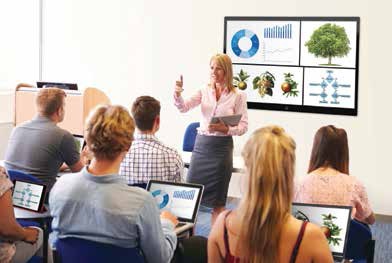Giving your higher ed end users the edge.
There is much change afoot in classroom technology and online learning. It’s where the two connect and overlap that will provide the most opportunity for a refresh in 2016.
1. NOT JUST ELECTRONIC POLLING, ELECTRONIC DISTANCE POLLING
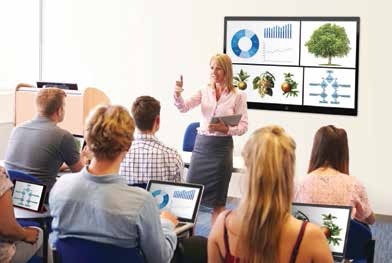
Kramer’s VIA Campus The statistic most often cited to support classroom polling is that the average human’s attention span begins to fade after 20 minutes. Few could pass a quiz on where this metric originated, but it is generally accepted that a focus refresh every 20 minutes can improve knowledge retention. Thus, the electronic poll has arisen as an engaging method of mental rebooting and simultaneous assessment of what subjects need more explanation.
About a decade into the wide use of hardware and software polling in classrooms has shown that students really do like it. Several free classroom polling platforms exist, and educators say that services such as Kahoot, which connect mobile devices for a real-time group survey, are ideal for the “BYOD, mixed device classroom.” But the next level on this is to connect to other classrooms via Google Hangout, Periscope, Skype or virtual conference, and play with students anywhere in the world.
Where do you go from there? Polling plus distance, plus collaboration. In addition to enabling wireless E-polling and connection with remote students via embedded third−party video conferencing and office apps, hardware like Kramer’s VIA Campus offers collaboration with up to six user screens on one main display, or up to 12 screens on two displays. From any laptop or mobile device, students and teachers can view the main display, edit documents together in real time, share any size file, or turn the main display into a digital whiteboard.
2. PLEASE, NO SURFING PUNS WITH WAVE 2 WI-FI
You’ve heard of Wi-Fi. But have you heard of better, faster, connectivity boosting 802.11ac Wave 2 Wi-Fi? Some universities are already replacing their entire network infrastructure with the faster stuff, hoping to outpace their upgrade cycle with at least one solid component to carry an institution through many a technology to come. Others are rolling out Wave 2 in key locations to keep connectivity buzzing in classrooms, student gathering places and major event spaces. Word on the street is, no one will really get the full benefit of Wave 2 until smartphone, tablet, and laptop manufacturers catch up.
3. SHARE THE PEDAGOGICAL SPOTLIGHT
The flipped classroom twists one more degree of rotation with teachers taking a cue from abundant online learning options and the success of MOOCs. In addition to in-classroom learning, instructors are providing curatorial guidance to online courses, conferences, and myriad other online materials. To keep the exchange even, and to support the flipped classroom approach of online lecture viewing and in-classroom collaboration, lecture capture has taken on new precedence. Technologies from Lumens, Sony, Sonic Foundry and more can handle both sides of the equation, streaming or recording live lectures. Recordings can be distributed automatically online for distance education, assistance for absent students, or supplementary course material.
4. BYOD-CASTING IS A THING
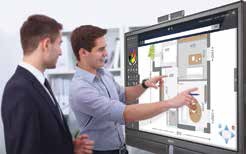
The InFocus Mondopad 2.0 Touchscreen teaching has existing in the wild for quite some time now, and educator feedback runs wide and deep. Essentially what the people want is an all-in-one collaboration tool for video conferencing, whiteboarding, web browsing and saving/sharing information or ideas. The 2.0 version of these tools will go where all education is going—beyond the classroom and campus to collaborate freely with other educational entities. For InFocus, going to the next level in this market meant gathering customer feedback and implementing more than 200 product improvements to its Mondopad. The new Mondopad 2.0 gives universities and colleges access to standard Windows apps that have been in use for years and allows customers to use virtually any videoconferencing service or third-party solution including Skype for Business. This all adds up to what InFocus called “BYOD casting,” which is a term that may catch on more broadly, as Mondopad 2.0 works with other mobile devices, enabling display casting and control capabilities from PCs and Macs or iOS or Android smartphones.
5 OMNIPRESENT TELEPRESENCE
The telepresence classroom has evolved into a fairly consistent layout of small groups of concentric-circled desks linked into a full orbit of a classroom via bi-directional video technology. Lines of sight were the first consideration in this set up, but what also came along as a pleasing byproduct of the structure is increased engagement among students who sit facing each other on and off screen. Additionally, the audio reinforcement and microphone setup necessary for far-end communications has serendipitously enabled every student to easily be heard. The next step in optimizing this room-to-room global chat is to give students full push-to-talk capabilities alongside document sharing on a device like the Taiden Paperless Multimedia Conference System from Media Vision. Elevate students’ engagement while simultaneously preparing them for the real world of meetings and conferences.
6. SPECIAL GUESTS IN THE CLASSROOM EVERY DAY
Specialist training is critical for fields of study both old and new, but the number of specialized educators is declining as a result of resource challenges and an ever-increasing intensity of focus within curricula. It takes a lot to be an expert in some fields, and subsequently there aren’t a lot of experts in some fields. To help achieve critical mass between the number of interested students scattered around the country and those who can educate them, new specialist distance learning companies are evolving. Companies such as iLaw, which connects law schools with the nuanced professors required to provide degrees in fields of specialty, are considering distance learning technology to be fait accompli at universities. Make sure your setup is current, with connectivity that is as specialized at the course material that will be piped through it.
7. BIGGER BANDWIDTH BY THE BOOKS
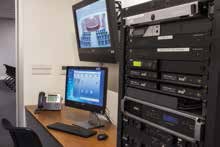
Utelogy’s system Homework was redefined when professors started sharing lectures online. And proof of positives outcomes recently came from MIT, where the percentage of students obtaining a final score of 90 percent or above in an introductory class in mechanical engineering, jumped from 10 percent in the fall semester of 2012, to 56 percent three years later, with the same professor covering the same material but with the addition of MITx online content. Similar results have been seen at all levels of higher education, and universities are beefing up their backends to enable better out-of-classroom experiences. Leveraging the existing IT infrastructure, technology provider Utelogy has gained traction with its integration of voice, video, lecture capture, distance learning and other academic and IT technologies. Utelogy Enterprise software sits on a virtual server in a college’s data center to control, monitor and remotely support smart classrooms, boardrooms and conference facilities across campuses.
8. NEW AND IMPROVED: THE HUMAN VOICE
With so much focus on new communications technologies on campus, it might be easy to forget what started it all in Socratic times. The human voice is not just important in a traditional pedagogical setup, it’s also key to distance communications and the multitude of digital tools that enhance learning today. Don’t give professors the equivalent of a choppy and jarring satellite phone feed for their lectures. Make sure they have a good wireless setup for live and recorded presentations.
9. HANDLE WITH CARE
The ever-present classroom video display, while not requiring as much cleaning as chalkboards, does require at least a little attention now and then. Many schools are going lampless in the projector department, and hanging many a shortthrow option right above the ubiquitous white board. Meanwhile, flat-panel video displays get thinner and higher-res by the moment, requiring constant replacement. So how you hang it up, whether it’s the hang and forget infinite life of laser projectors or the constantly in motion old stand-by mobile video cart that can roll in the newest 4K concoction, make sure it’s built for that specific school use. Security, ADA compliance, plenum rating and a multitude of form factors continue to improve for today’s aptly rebranded “interactive mounts.”
10. THE VITAMIX OF BLENDED LEARNING
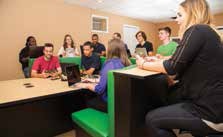
FSR’s HuddleVu in action You can bring the online learning to the classroom, but you can’t make the students think. It turns out that until recent upgrades in technology, the addition of online course material in an interdepartmental move made by Imperial College London was ineffective. Engineering students were offered business courses online five years ago, but they didn’t take the bait until true collaboration was introduced. It seems that students demand collaborative tools that allow them to amplify collective efforts. Particularly when they are together in a classroom taking online courses, students are more engaged when they have collaborative learning technologies, like FSR’s HuddleVU, to enhance the way they absorb, retain, interact with and relate to information and to each other. Designed specifically with educational environments in mind, FSR’s HuddleVU collaboration products can be configured for a variety of educational spaces, are intuitive to use, and built to last in high-use, student centered areas and that don’t require software downloads or wireless access.
11. THE BIG PICTURE IN GAME DESIGN
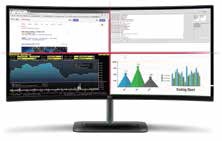
According to the Entertainment Software Association (ESA), today there are 496 post secondary game design programs found in colleges and universities across the U.S. This field of study is serious business, both in terms of boosting enrollment and helping to ensure that students graduate into a viable career track. With this demand comes a need for upgrades to individual desktop displays in the classroom. Make students want to show up for class with displays like LG’s new 21:9 34UC87M-B Curved UltraWide Monitor. This workstation dazzler goes big with its 3440x1440 QHD screen, providing 2.4 times the work space than a standard 16:9 Full HD model. A four-screen split feature allows users to divide the screen into four sections at eight different screen ratios, so users can prioritize windows by size and location instead of having to manually resize and position each window individually.
12. “CHANGE MANAGEMENT ACTIVITIES” IS THE ACADEMIC PHRASE FOR UC
As a business entity, institutions for higher learning must manage distributed teams across campuses and multiple locations. Why not give them the gift of Unified Communications? Some schools might have to designate the budget as funding for “change management activities,” to meet academic lingo standards, but really what the RFP is requesting is an end to the frustration created by disconnected communications technologies.
13. SMARTER VIDEO MANAGEMENT
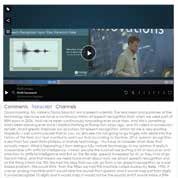
Students expect to find their video classwork as easily as searching YouTube. Ramp Video Management lets students search for videos based on their contents or jump to an exact keyword in the middle of a lecture for a pertinent piece of information. Videos stream to the student’s desktop, tablet and smartphone. With a systems-based API, Ramp Video Management can integrate with any learning management system, and the video content is secure, controlled, and measurable.
14. PERSONALIZED LISTENING
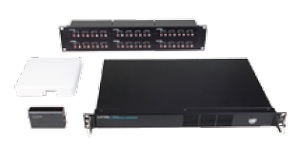
The ListenWiFi Personal Listening System lets colleges offer a personal listening/ viewing experience by streaming audio content from any TV or audio source directly to their student’s smartphones and tablets using a Wi-Fi network. The University of California Riverside chose the ListenWiFi System for use in its student recreation center to broadcast audio from multiple TV channels or other audio sources using digital WiFi transmission. Using the free ListenWiFi App available from the Apple App Store or Google Play, students can bring their own WiFi-enabled device and headphones or ear buds and easily switch audio channels with the flick of a thumb. ISP connectivity also provides Internet access for customers connected to the ListenWiFi network.
